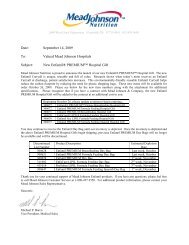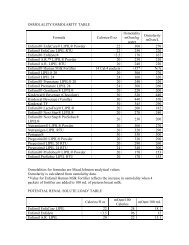You also want an ePaper? Increase the reach of your titles
YUMPU automatically turns print PDFs into web optimized ePapers that Google loves.
Method 2 – AWP + Service ChargeMore and more payers are interested in an AverageWholesale Price (AWP) plus a service charge that includesenteral supplies and provider services. AWPs are found ineither the Red Book or the Blue Book and are established<strong>by</strong> independent sources. Private payers will negotiateeither a percentage off of AWP (e.g., -10% AWP), AWP oran AWP plus (AWP +5%) rate as well as the service chargefor the product. In order to establish a service rate, youhave to understand the costs including:❏ Enteral products❏ Enteral supplies❏ Enteral equipment❏ Pharmacy costs❏ Nursing costs❏ Delivery costs❏ Billing and collections costs❏ OverheadThese can be estimated for each product line or thefinance department can calculate a detailed Activity BasedCost (ABC) amount for typical enteral patients.CapitationCapitation is a form of payment which is made to aprovider on a per member per month (PMPM) basis.Capitation payments are generally made at the beginning ofthe month and they precede the provision of service tomembers. Per member per month rates are determined <strong>by</strong>estimating the cost of providing care to the given managedcare member population, then adding a profit factor to thecalculation. Capitation estimates are generally calculatedfor a period of one year because it is usually difficult tomake predictions beyond this period of time.Capitation payments are made to a providerregardless of the amount of services provided to thepopulation being serviced. If the provider’s costs ofservices are higher than expected, the provider losesmoney. If the provider’s costs of services are lower thanexpected, the provider makes money. The art of capitationis complex, and involves good estimation skills andappropriate financial information about the memberpopulation in order to calculate the best rate. The methodfor establishing capitation rates is to:❏ Make assumptions about the expected utilizationof provider services with the MCO enrolleepopulation; this is usually difficult to do becauseonly past and current utilization is available andoften this data is sketchy; providers should❏❏evaluate the potential volume in a managed careorganization and make assumptions about howmuch the current volume will increase ordecrease with their services.The average rate per service is determinedThe expected utilization is multiplied <strong>by</strong> theaverage rate per service, then this is adjusted <strong>by</strong>any member co-payment amount❏ This equals the pmpm capitation amountThe following is an example of a capitationcalculation:$600,000 utilization of providerservices expected÷ 20,000 enrollees$30 per member per year (pmpy)- $6 co-payment$24 pmpy÷ 12 month$2 pmpm capitation rateIn some capitation situations, enrollees areresponsible for paying a co-payment amount. If they are,the co-payment amount would be subtracted from the totalper member per month amount which would be paid <strong>by</strong>the managed care organization and the provider wouldcollect the co-payment amount directly from the enrollee.Managed care organizations may present providerswith data which they have generated internally.Oftentimes, this information is sketchy and may not beaccurate. Managed care organizations have differentcomputer systems, and it can be difficult for them to linkthese systems together to generate accurate data. In somesituations, the provider may be asked to work with theinformation systems department within the managed careorganization to develop a process to get specificinformation required <strong>by</strong> the provider.Managed care data, like internally generated data, willchange over time as the enrollee population shifts, newservices are covered, and the utilization of services shiftswithin the enrollee population. Ideally, providers will usea variety of methods to arrive at a capitation rate estimateand understand that it is nearly impossible to generate aperfect number. Capitation is a process of estimation, andas providers and MCOs work together, both become bettereducated about the meaning of these estimates.There are different methods of establishing capitationrates. These are percentage of premium, percentage ofpremium with a guarantee, flat per member per monthrates, and variable rates.72May, 2002
















